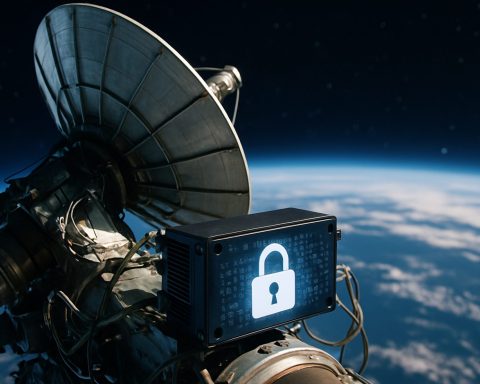- SpaceX launched a Falcon 9 rocket from Kennedy Space Center, carrying 21 Starlink satellites.
- The mission featured the successful landing of the Falcon 9 first-stage booster on the droneship “A Shortfall of Gravitas.”
- Thirteen satellites include Direct to Cell technology, aiming to eliminate cellular dead zones globally.
- SpaceX partners with T-Mobile to enhance mobile communication, promising connectivity even in remote areas.
- The launch represents the 41st Falcon 9 mission in 2025, underscoring SpaceX’s commitment to global internet access.
- SpaceX’s growing satellite constellation aims to provide fast, low-latency internet worldwide, uniting technology and innovation.
As the world slumbered beneath a radiant full moon, SpaceX orchestrated a dazzling display of engineering prowess from Florida’s Kennedy Space Center. A Falcon 9 rocket, resolute and magnificent, took flight into the serene morning sky, marking yet another chapter in the saga of connectivity that weaves its way across the globe. At precisely 8:53 a.m. EDT, the rocket catapulted upwards from the historic Launch Complex-39A, piercing the tranquil atmosphere with its powerful roar—a modern marvel in motion.
Propelled by the might of nine Merlin engines, the first stage of this technological titan, known as Booster B1083, soared ever higher before achieving the graceful choreography of separation only 2.5 minutes into its journey. As the second stage continued its celestial climb laden with 21 Starlink satellites, B1083 executed a flawless landing on A Shortfall of Gravitas, a droneship adrift in the vast Atlantic Ocean. In six brief minutes, SpaceX had reaffirmed its mastery over the delicate dance of rocketry.
Above, the upper stage pressed onward, transcending the boundaries of Earth with its precious cargo. Thirteen of these satellites are equipped with the groundbreaking Direct to Cell technology, a beacon of future connectivity poised to obliterate cellular dead zones worldwide. Partnering with T-Mobile, SpaceX stands on the brink of revolutionizing mobile communication, promising seamless service even in the most remote corners of the globe.
As the clock ticked towards the hour mark, the Starlink satellites were released, embarking on their own voyage into specific orbits. Each one assumed its position within SpaceX’s ever-expanding megaconstellation, an intricate latticework encircling our planet. This marks the 41st Falcon 9 mission of 2025, a testament to the relentless pursuit of a vision where lightning-fast, low-latency internet connects us all, regardless of geography.
Janus-like, SpaceX looks both backward towards a legacy of innovation and forward to a world united by technology. Their odyssey continues, a stellar ballet bringing humanity one step closer to an intricately connected future. As we gaze up, these satellites become the heralds of change, promising a world without borders—a world where the night sky whispers of possibility and progress, etched against the canvas of infinity.
SpaceX’s Starlink Expansion: Key Takeaways and Future Prospects
Introduction
SpaceX’s successful launch from Kennedy Space Center signifies a leap forward in satellite internet connectivity, leveraging the Falcon 9 rocket to deploy the latest batch of Starlink satellites. As part of a robust mission strategy, SpaceX aims to provide global internet access by enhancing their satellite constellation.
How-To Steps & Life Hacks
Getting Starlink Internet Service
1. Check Availability: Visit the Starlink website to see if service is available in your area.
2. Place an Order: If available, sign up and order the Starlink Kit.
3. Setup Kit: Upon receiving your kit, follow the setup instructions to install the satellite dish and connect it to the network.
4. Connect Devices: Use the Starlink app to manage your network and connect devices.
Real-World Use Cases
1. Remote Connectivity: Ideal for rural and remote areas lacking traditional broadband infrastructure.
2. Emergency Response: Provides critical communication capabilities in disaster-stricken regions.
3. Maritime and Aeronautical Applications: Enhances onboard communication for ships and aircraft.
Market Forecasts & Industry Trends
– Expanding Satellite Internet Market: The global satellite internet market is projected to reach USD 8 billion by 2030, driven by demand for connectivity in underserved regions.
– Growth of Satellite Megaconstellations: Companies like SpaceX, Amazon, and OneWeb are increasing the deployment of satellite constellations to enhance global coverage.
Reviews & Comparisons
– Starlink vs. Traditional ISPs: Starlink offers faster speeds and broader coverage in rural areas compared to traditional ISPs, but urban areas might see competitive performance from fiber optic providers.
– Competitor Overview: Compared to Amazon’s Project Kuiper and OneWeb, Starlink currently has a larger operational satellite network.
Features, Specs & Pricing
– Direct to Cell Technology: Offers enhanced mobile coverage by integrating with existing cell networks.
– Pricing: Starlink’s service costs approximately USD 110 per month, plus a one-time fee for the hardware setup.
Security & Sustainability
– Cybersecurity Measures: Ensures robust data protection and transmission security.
– Sustainability Efforts: SpaceX is researching ways to minimize space debris through satellite design and end-of-life disposal techniques.
Pros & Cons Overview
Pros
– Global Access: Provides internet service where traditional ISPs can’t reach.
– High-Speed Connectivity: Offers competitive download speeds.
Cons
– Initial Cost: Higher initial equipment cost compared to traditional services.
– Weather Dependency: Performance can be affected by weather conditions.
Controversies & Limitations
– Light Pollution Concerns: Astronomers express concerns about the impact of satellite constellations on astronomical observations.
– Regulatory Challenges: Navigating international regulations for satellite operation and frequency allocation.
Insights & Predictions
– Future Innovators: SpaceX’s model may stimulate further innovation and competition in the satellite internet market.
– Interdisciplinary Partnerships: Collaborations with telecom leaders like T-Mobile may pave the way for integrated global networks.
Actionable Recommendations
– Leverage Starlink for Remote Work: Consider Starlink to improve internet access in work-from-home settings.
– Explore Government Subsidies: Look into potential governmental subsidies to offset installation costs.
For more information about SpaceX and their groundbreaking initiatives, visit their official website.
Conclusion
SpaceX’s Starlink satellite initiative continues to redefine possibilities for global communication. Whether enhancing connectivity in remote locations or blazing trails in space innovation, SpaceX’s strategic endeavors promise to reshape how the world connects—one launch at a time.








